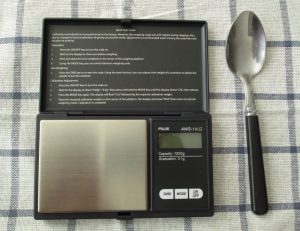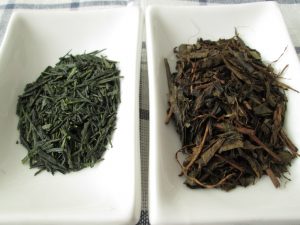 Have you ever tried measuring tea leaves to make a cup of tea by weight instead of volume?
Have you ever tried measuring tea leaves to make a cup of tea by weight instead of volume?
Most tea drinkers just use a teaspoon and there’s nothing wrong with that, but us tea geeks sometimes need to go a step further.
We want to be sure that we’re using the right amount of tea leaves of our precious gyokuro which we are about to drink with friends.
Measuring by volume
A teaspoon is actually a standard measure, which equals 1/6 fl oz, or about 5 ml. You’ll need a measuring spoon though, because a common teaspoon won’t have a precise measure.
If you try to measure tea leaves with a teaspoon, you’ll find that the leaves don’t fit nicely. Some leaves are too long and stick out, and others are too big and leave a lot of empty space.
Tea leaves differ depending on the type of tea, so measuring by volume is not accurate.
Measuring by weight
To get better results, you need to measure the tea leaves on a scale. The most common is to measure in grams.
 For a comparison, I took a picture of 4 grams of both gyokuro and houjicha. Notice how houjicha has more than twice the volume as gyokuro for the same weight.
For a comparison, I took a picture of 4 grams of both gyokuro and houjicha. Notice how houjicha has more than twice the volume as gyokuro for the same weight.
I have a small scale that is very handy, the AWS scale that measures up to tenths of a gram. But as you can imagine, it takes more time than measuring with a teaspoon.
My advice is that whenever you are brewing a specific tea for a first time, use a scale so that you get a general idea of what volume of tea leaves you will need next time that you use a teaspoon.
You’re free to brew as you prefer, and obviously you don’t have to measure tea leaves to the nearest gram and infuse to the exact time. But it’s always helpful to begin with a standard, and then you can take it from there.

August 1, 2014
We have the same scale! 😀
…or the same brand anyway…
Lately I have been frequently using a scale, but I still think there is something to be said about measuring with a spoon.
There is something transcendent about using only your sight and senses to measure the proper amount of leaf. It’s a skill that I think gives the brewer a closer connection to the tea.
But in any case, I really enjoyed this helpful article. Thumbs up 🙂
August 1, 2014
Hi Griff
Thanks for the comment.
I use the scale mainly when doing a tea review or trying out a new tea. For the rest of the time I use a spoon too.
As you say, it’s still a good skill to have, in olden times the tea masters didn’t have access to this technology 🙂
January 27, 2021
Hi guys,
Where can I buy one of those scales pictured.
Regards steve
January 27, 2021
Hi Stephen.
I bought it from Amazon in the US. You can see the link in the post.
It’s a very good scale, after all this years it still works perfectly.
March 17, 2015
Hi,
I blend my own organic loose leaf teas here in Canada and I’m stumped on this. I’ve always sold by volume but can not seem to kick the idea that either 1. I should include the weight in grams on my packages or 2. I should be selling by weight instead of volume.
I wish I were kidding when I say, I wake up each morning thinking about teas and this question has continually plagued me….over and over. My sister-in-law is the only customer I’ve had ask about grams so it’s not as though customers have been concerned about it but that said, it has been grating on me…”there has got to be a reason why tea is sold by weight”.
Hear me out:
-I brew per tea spoon though I buy my herbs/pound
-I do not wish to have more than 2-3 different sizes of packaging (of which differ in volume) (if I’m selling by weight, there would be so so so many different weights when considering all of my blends/different packages).
-I thought it would look funny to have differing numbers (the weight) on each package
-All of my recipes are either per Cup or Part always have been
HOWEVER
-Tea is sold by weight
-Herbs for teas are purchased according to weight
-While starting a company with a product that has been around since the beginning of times one should probably stick to the status quo?!
What are your thoughts?
Thanks 🙂
March 17, 2015
Hi Krista
Yes, tea is normally sold by weight, but I see no problem with selling your teas by volume in the sense that people can still figure out the number of teaspoons inside the package and thus how many cups a given tea would make.
There are disadvantages to both, for example the hard stems in bancha add a lot of weight and not much volume but has no flavor, while for example a given herb adds a lot of volume and weights little but is the cheapest ingredient in the blend.
I’m not exactly sure but I think that there are regulations so that weight should always be displayed, I guess it depends on many things.